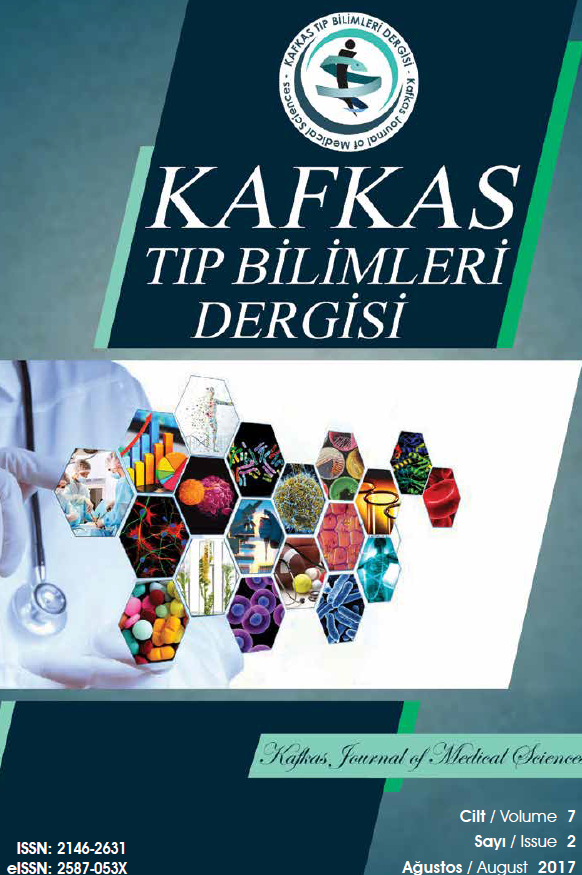Meme Kanseri Olgularının Retrospektif Değerlendirilmesi
meme kanseri; östrojen reseptörü; progesteron reseptörü; HER2, moleküler alt tip
___
- 1. Ferlay J, Soerjomataram I, Dikshit R, Eser S, Mathers C, Rebelo M, et al. Cancer incidence and mortality worldwide: Sources, methods and major patterns in GLOBOCAN 2012. Int JCancer 2015;136:359–86.
- 2. Network, CGA. Comprehensive molecular portraits of human breast tumours. Nature 2012;490:61–70.
- 3. Ma C, Nepal M, Kim JH, Fan P, Fei P. A new look at molecular biology of breast cancer. Cancer Biol Ther 2019;20(1):1–5.
- 4. Pérez-Rodríguez G. Prevalence of breast cancer sub-types by immunohistochemistry in patients in the Regional General Hospital 72, Instituto Mexicano del Seguro Social. Cir 2015;83(3):193–8.
- 5. Cavalli LR, Cavalli IJ. Molecular classification and prognostic signatures of breast tumors. In: Urban C, Rietjens M, El-Tamer M, Sacchini V (eds) Oncoplastic and reconstructive breast surgery. Springer, Cham; 2019, pp.129–138.
- 6. Prat A, Pineda E, Adamo B, Galván P, Fernández A, Gaba L, et al. Clinical implications of the intrinsic molecular subtypes of breast cancer. Breast 2015;24(2):S26-S35.
- 7. Schnitt SJ. Classification and prognosis of invasive breast cancer: from morphology to molecular taxonomy. Modern Pathology 2010;23:S60-S64.
- 8. Polyak K. Heterogeneity in breast cancer. J Clin Invest 2011;3;121(10):3786–3788.
- 9. Alcalá-Corona SA, Anda-Jáuregui G, Espinal-Enríquez J, Hernández-Lemus E. Network modularity in breast cancer molecular subtypes. Front Physiol 2017;8:915.
- 10. Tang P, Tse GM. Immunohistochemical surrogates for molecular classification of breast carcinoma: A 2015 update. Arch Pathol Lab Med 2016;140(8):806–14.
- 11. Collins LC, Marotti JD, Gelber S, Cole K, Ruddy K, Kereakoglow S, et al. Pathologic features and molecular phenotype by patient age in a large cohort of young women with breast cancer. Breast Cancer Res Treat 2012;131(3):1061–6.
- 12. Lakhani SR, Ellis IO, Schnitt SJ, Tan PH, van de Vijver MJ. WHO Classification of Tumours of the Breast, 4th ed. Lyon, IARC Press; 2012, pp.143–7.
- 13. Viale G. The current state of breast cancer classification. Annals of Oncology 2012;23(10):x207-x210.
- 14. Abubakar M, Figueroa J, Ali HR, Blows F, Lissowska J, Caldas C, Easton DF, et al. Combined quantitative measures of ER, PR, HER2, and KI67 provide more prognostic information than categorical combinations in luminal breast cancer. Modern Pathology 2019; Apr 11.
- 15. Tekin L, Doğan E. Meme kanserlerinin alt tiplerine göre patolojik özelliklerinin değerlendirilmesi. FÜ Sağ Bil Tıp Derg 2018;32(3):129–132.
- 16. Kondov B, Milenkovikj Z, Kondov G, Petrushevska G, Basheska N, Bogdanovska-Todorovska M, et al. Presentation of the molecular subtypes of breast cancer detected by ımmunohistochemistry in surgically treated patients. Maced J Med Sci 2018 6;6(6), 961–967.
- 17. Ünçel M, Aköz G, Yıldırım Z, Pişkin G, Değirmenci M, Solakoğlu et al. Meme kanserinin klinikopatolojik özelliklerinin moleküler alt tipe göre değerlendirilmesi. Tepecik Eğit Araşt Hast Derg 2015;25(3):151–156.
- 18. Landry AP, Zador Z, Haq R, Cusimano MD. Reclassification of breast cancer: towards improved diagnosis and outcome. PLoS One 2019;22;14(5): e0217036.
- 19. Eliyatkın N, Yalçın E, Zengel B, Aktaş S, Vardar E. Meme karsinomunda moleküler sınıflama: gelenekselden yeni döneme yolculuk. J Breast Health 2015;11:59–66.
- 20. Waks AG, Winer EP. Breast Cancer Treatment, A Review. JAMA 2019;321(3):288–300.
- 21. Giraldo NA, Peske JD, Sautès-Fridman C, Fridman WH. Integrating histopathology, immune biomarkers, and molecular subgroups in solid cancer: the next step in precision oncology. Virchows Archiv 2019;474(4):463–474.
- 22. Fallahpour S, Navaneelan T, De P, Borgo A. Breast cancer survival by molecular subtype: a population-based analysis of cancer registry data. CMAJ Open 2017;5(3): E734-E739.
- 23. Vallejos CS, Gómez HL, Cruz WR, Pinto JA, Dyer RR, Velarde R, et al. Breast cancer classification according to immunohistochemistry markers: subtypes and association with clinicopathologic variables in a peruvian hospital database. Clin Breast Cancer 2010;10(4):294–300.
- 24. Ihemelandu CU, Leffall LD Jr, Dewitty RL, Naab TJ, Mezghebe HM, Makambi KH, et al. Molecular breast cancer subtypes in premenopausal and postmenopausal AfricanAmerican women: age-specific prevalence and survival. J Surg Res 2007;143(1):109–18.
- 25. Parise CA, Caggiano V. Differences in clinicopatholgic characteristics and risk of mortality between the triple positive and ER+/PR+/HER2− breast cancer subtypes. Cancer Causes Control 2019, 30, 5, 417–424.
- 26. Prado-Vázquez G, Gámez-Pozo A, Trilla-Fuertes L, Arevalillo JM, Zapater-Moros A, Ferrer-Gómez M, et al. A novel approach to triple-negative breast cancer molecular classification reveals a luminal immune-positive subgroup with good prognoses. Scientific Reports 2019;9, 1538.
- 27. Garrido-Castro AC, Lin NU, Polyak K. Insights into molecular classifications of triple-negative breast cancer: ımproving patient selection for treatment. Cancer Discov 2019;9(2):176–198.
- 28. Munoz DF, Plevritis SK. Estimating breast cancer survival by molecular subtype in the absence of screening and adjuvant treatment. Med Decis Making 2018;38(1):32S-43S.
- ISSN: 2146-2631
- Yayın Aralığı: Yılda 3 Sayı
- Başlangıç: 2011
- Yayıncı: Kafkas Üniversitesi
Demir Eksikliği Anemisinde Ferrik Karboksimaltoz ile Oral Demir Tedavisinin Karşılaştırılması
Muharrem BAYRAK, Kenan ÇADIRCI
İstanbul’da ve Kars’ta Yaşayan Gebelerin Prenatal Bağlanma Düzeyleri ve Etkileyen Faktörler
Özlem KARABULUTLU, Kerime Derya BEYDAĞ, Merve LAZOĞLU
Meme Kanseri Olgularının Retrospektif Değerlendirilmesi
Tuba DEVRİM, Merva AYDEMİR AKKAYA, Pınar ATASOY, Mahi BALCI, Canan ALTUNKAYA, Mehmet ZENGİN
Geç Preterm ve Term Yenidoğanların Klinik Özellikleri: Bir Vaka Kontrol Çalışması
Feyza Ustabaş KAHRAMAN, Hüsnü Fahri OVALI, Zeliha Aysu SAY
Kifoplasti ve Vertebroplasti Operasyonlarının Klinik ve Radyolojik Olarak Değerlendirilmesi
Ümit Ali MALÇOK, Özbey ŞAFAK, Tarık AKMAN, Adem Bozkurt ARAS
Nadir Bir Vaka: Pulmoner Ksantom
Mehlika İŞCAN, Merve EKİNCİ, Nil COMUNOĞLU, Mehmet Kamil KAYNAK
Benign Anorektal Hastalıklarda Beslenme ve Kabızlık Durumunun Değerlendirilmesi
İdiopatik Parkinson Hastalığında Tiyol-disülfid Homeostazisi
Aybala Neslihan ALAGÖZ, Nimet Uçaroğlu CAN, Hayrullah YAZAR, Sıdıka Sinem TAŞDEMİR
